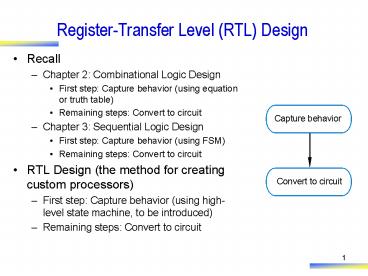RegisterTransfer Level RTL Design - PowerPoint PPT Presentation
Title:
RegisterTransfer Level RTL Design
Description:
First step: Capture behavior (using equation or truth table) ... Example of how to create a high-level state machine to describe desired processor behavior ... – PowerPoint PPT presentation
Number of Views:46
Avg rating:3.0/5.0
Title: RegisterTransfer Level RTL Design
1
Register-Transfer Level (RTL) Design
- Recall
- Chapter 2 Combinational Logic Design
- First step Capture behavior (using equation or
truth table) - Remaining steps Convert to circuit
- Chapter 3 Sequential Logic Design
- First step Capture behavior (using FSM)
- Remaining steps Convert to circuit
- RTL Design (the method for creating custom
processors) - First step Capture behavior (using high-level
state machine, to be introduced) - Remaining steps Convert to circuit
Capture behavior
Convert to circuit
2
RTL Design Method
3
Step 1 Laser-Based Distance Measurer
- Example of how to create a high-level state
machine to describe desired processor behavior - Laser-based distance measurement pulse laser,
measure time T to sense reflection - Laser light travels at speed of light, 3108
m/sec - Distance is thus D T sec 3108 m/sec / 2
4
Step 1 Laser-Based Distance Measurer
T (in seconds)
laser
sensor
- Inputs/outputs
- B bit input, from button to begin measurement
- L bit output, activates laser
- S bit input, senses laser reflection
- D 16-bit output, displays computed distance
5
Step 1 Laser-Based Distance Measurer
Inputs
B
, S
(1 bit each)
Outputs
L (bit), D (16 bits)
a
- Step 1 Create high-level state machine
- Begin by declaring inputs and outputs
- Create initial state, name it S0
- Initialize laser to off (L0)
- Initialize displayed distance to 0 (D0)
6
Step 1 Laser-Based Distance Measurer
Inputs B, S (1 bit each)
Outputs L (bit), D (16 bits)
a
S0
S0
L 0
D 0
- Add another state, call S1, that waits for a
button press - B stay in S1, keep waiting
- B go to a new state S2
Q What should S2 do?
A Turn on the laser
a
7
Step 1 Laser-Based Distance Measurer
Inputs B, S (1 bit each)
Outputs L (bit), D (16 bits)
B
S0
S1
S2
B
a
L 0
L 1
D 0
(laser on)
- Add a state S2 that turns on the laser (L1)
- Then turn off laser (L0) in a state S3
Q What do next?
A Start timer, wait to sense reflection
a
8
Step 1 Laser-Based Distance Measurer
Inputs B, S (1 bit each)
Outputs L (bit), D (16 bits)
Local Registers Dctr (16 bits)
B
S0
S1
S2
S3
B
L 0
L 1
L 0
a
D 0
- Stay in S3 until sense reflection (S)
- To measure time, count cycles for which we are in
S3 - To count, declare local register Dctr
- Increment Dctr each cycle in S3
- Initialize Dctr to 0 in S1. S2 would have been
O.K. too
9
Step 1 Laser-Based Distance Measurer
Inputs B, S (1 bit each)
Outputs L (bit), D (16 bits)
Local Registers Dctr (16 bits)
S
B
a
S0
S1
S2
S3
B
S
L 0
L 1
L0
Dctr 0
D 0
Dctr Dctr 1
- Once reflection detected (S), go to new state S4
- Calculate distance
- Assuming clock frequency is 3x108, Dctr holds
number of meters, so DDctr/2 - After S4, go back to S1 to wait for button again
10
Step 2 Create a Datapath
- Datapath must
- Implement data storage
- Implement data computations
- Look at high-level state machine, do three
substeps - (a) Make data inputs/outputs be datapath
inputs/outputs - (b) Instantiate declared registers into the
datapath (also instantiate a register for each
data output) - (c) Examine every state and transition, and
instantiate datapath components and connections
to implement any data computations
Instantiate to introduce a new component into a
design.
11
Step 2 Laser-Based Distance Measurer
Inputs B, S (1 bit each)
Outputs L (bit), D (16 bits)
- (a) Make data inputs/outputs be datapath
inputs/outputs - (b) Instantiate declared registers into the
datapath (also instantiate a register for each
data output) - (c) Examine every state and transition, and
instantiate datapath components and connections
to implement any data computations
a
D
a
tap
a
th
12
Step 2 Laser-Based Distance Measurer
Inputs B, S (1 bit each)
Outputs L (bit), D (16 bits)
- (c) (continued) Examine every state and
transition, and instantiate datapath components
and connections to implement any data
computations
a
D
a
tap
a
th
D
r
eg_clr
D
r
eg_ld
clear
clear
I
D
c
tr_clr
D
c
t
r
16-bit
D
r
eg 16-bit
c
ou
n
t
load
D
c
tr_c
n
t
u
p
-
c
ou
n
t
er
r
e
g
is
t
er
Q
Q
16
D
13
Step 3 Connecting the Datapath to a Controller
- Laser-based distance measurer example
- Easy just connect all control signals between
controller and datapath
14
Step 4 Deriving the Controllers FSM
- FSM has same structure as high-level state
machine - Inputs/outputs all bits now
- Replace data operations by bit operations using
datapath
a
Dreg_clr 1 Dreg_ld 0 Dctr_clr 0 Dctr_cnt
0 (laser off) (clear D reg)
Dreg_clr 0 Dreg_ld 0 Dctr_clr 1 Dctr_cnt
0 (clear count)
Dreg_clr 0 Dreg_ld 0 Dctr_clr 0 Dctr_cnt
0 (laser on)
Dreg_clr 0 Dreg_ld 0 Dctr_clr 0 Dctr_cnt
1 (laser off) (count up)
Dreg_clr 0 Dreg_ld 1 Dctr_clr 0 Dctr_cnt
0 (load D reg with Dctr/2) (stop counting)
15
Step 4 Deriving the Controllers FSM
- Using shorthand of outputs not assigned
implicitly assigned 0
a
16
Step 4
Dreg_ld
Dctr_clr
Dctr_cnt
- Implement FSM as state register and logic (Ch3)
to complete the design






























